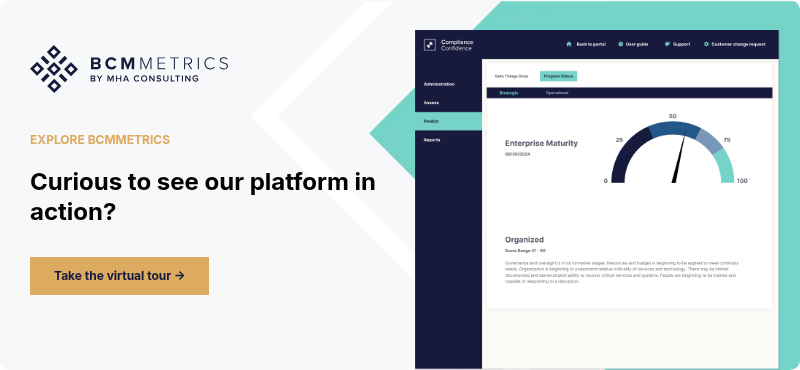Prepare For the Worst with the Best in the Business
Experience capable, consistent, and easy-to-use business continuity management software.
Disaster recovery is where your continuity plan transitions from theory to practice.
When a threat to your business arises, such as a ransomware attack, a regional outage that knocks systems offline, or a cyberattack that locks you out, your ability to recover quickly is all that matters.
The problem? Most teams don't know their plan has holes until they're already in the middle of the crisis. The documents are outdated. The steps are manual, scattered across spreadsheets and emails. The backup? It either failed silently or was never tested under real conditions. Now the clock is ticking, and complexity slows everything down.
This guide walks through 7 disaster recovery solutions designed to help you recover faster, minimize downtime, and avoid the scramble when every second counts.
What to Look for in a Disaster Recovery Solution
Choosing a disaster recovery solution can feel overwhelming, but we’re here to help you cut through all the noise.
Don’t base your decision on price alone. The most effective DR tools are those that align with your recovery goals, compliance needs, and operational realities. Look for tools that give you:
- Recovery Time Objectives (RTO) and Recovery Point Objectives (RPO): How quickly do you need to get systems back online? How much data can you afford to lose? These are your recovery goals, make sure your solution can meet them.
- Compliance and Security: If you operate in a regulated industry like healthcare or finance, your DR solution must align with those rules. Look for solutions with built-in compliance reporting and strong security measures.
- Total Cost of Ownership (TCO): Don’t just look at the price tag. Factor in costs like storage, data transfer, support, and any unexpected fees.
- Automation and Ease of Use: Your team should be able to use the solution without specialized training. Automated testing and failover can save you when the pressure is high.
- Vendor Reliability and Support: Make sure the vendor has a strong reputation and offers 24/7 support. A DR solution is only as good as the help you get when something goes wrong.
Not sure about the difference between business continuity and disaster recovery? Find out more in our blog.
The Top 7 Disaster Recovery Platforms for Business Continuity
There are many DRaaS options available, but not all solutions are created equal.
|
Solution |
Best For |
Key Features |
Potential Drawbacks |
|
BCMMetrics |
Easy to use, practical, and affordable BC management |
Full lifecycle: BIAs, plans, and testing. Compliance automation, real-time dashboards |
Limited to BC/DR management |
|
Cyber Command |
Complex hybrid cloud setups |
Customizable workflows, Kubernetes support, multi-cloud capability |
Requires customization for optimal use |
|
Azure Site Recovery |
Azure-centric environments |
Cloud-to-cloud failover, multi-platform support, cost-efficient |
Best for Azure environments |
|
Veeam Replication and DRaaS |
Rapid ransomware recovery |
SureBackup testing, CDP, instant VM recovery |
May be complex for small teams |
|
Unitrends |
Compliance-focused industries |
Compliance automation, AI-driven predictions, immutable backups |
User interface can feel outdated |
|
Zerto |
Hyperconverged infrastructure |
CDP, multi-cloud mobility, non-disruptive testing |
Higher cost for enterprise use |
|
Acronis Cyber Protect Cloud |
Managed service providers |
Integrated cybersecurity, multi-tenant management, ransomware detection |
Complex for smaller organizations |
We’ve selected the top seven based on their reliability, ease of use, and ability to support critical business functions. Whether you’re a small team or a large enterprise, these solutions can help you stay resilient.
1. BCMMetrics: Best for Smart, Straightforward Business Continuity
BCMMetrics is a business continuity software built for healthcare, financial, insurance, and utility organizations that are tired of managing compliance and recovery planning in Word and Excel, but don’t want to pay enterprise software prices or fight through complex tools.
Key features:
- End-to-End Management: Supports the full lifecycle of business continuity, from conducting BIAs and writing recovery plans to compliance tracking and exercise management.
- Compliance Automation: Provides pre-built compliance assessments based on industry standards (HIPAA, PCI DSS) with automated tracking and reporting.
- Real-Time Reporting and Dashboards: Offers visibility into program status, compliance, and resilience, helping teams identify strengths and gaps.
- Secure Document Management: Supports location-based storage of plans, incident reports, and other critical documents.
- User-Friendly Interface: Designed to be practical and straightforward without unnecessary complexity .
Why BCMs and Executives Like It: A straightforward, affordable solution with module-based pricing that helps you manage your continuity program without the complexity of traditional DR tools.
Fun fact: BCMMetrics was built by the business continuity experts at MHA Consulting. They used it to manage their internal projects, and eventually decided to launch it as its own program because it was too good not to share!
Potential Drawbacks:
BCMMetrics is primarily focused on business continuity and disaster recovery management, which may not meet the needs of organizations looking for heavy-duty server replication or IT-managed failover automation.
2. Cyber Command: Best for Complex Hybrid Cloud Setups
Cyber Command is designed for organizations with complex hybrid cloud environments, offering customizable workflows and robust Kubernetes support.
Key features:
- Customizable Disaster Recovery Workflows: Enables organizations to tailor recovery processes for different applications and infrastructure.
- Kubernetes Integration: Supports disaster recovery for containerized applications running on Kubernetes clusters.
- Multi-Cloud Compatibility: Works across on-premises, hybrid, and cloud environments for versatile deployment.
- Automated Failover: Ensures critical applications are automatically redirected during outages.
- Compliance Reporting: Provides built-in compliance tools for industry regulations.
Potential Drawbacks:
- Cyber Command requires customization to fit specific environments, which can lead to a steep learning curve for smaller teams.
3. Azure Site Recovery: Best for Azure-Centric Environments
Azure Site Recovery is Microsoft’s cloud-native disaster recovery solution, ideal for organizations using Azure and seeking cost-efficient cloud-to-cloud failover.
Key features:
- Cloud-to-Cloud Failover: Supports failover and recovery for Azure VMs, ensuring business continuity across Azure regions.
- Multi-Platform Support: Works with VMware, Hyper-V, and physical servers, offering flexibility.
- Cost-Efficient Pricing: Pay-as-you-go pricing model with clear cost management.
- Automated Failover and Recovery Plans: Configurable recovery plans for different applications.
- Seamless Integration with Azure Services: Easily integrates with other Azure tools for monitoring and security.
Potential Drawbacks:
- Azure Site Recovery is best for organizations already heavily invested in Azure. Limited benefits for non-Azure environments.
4. Veeam Replication and DRaaS: Best for Rapid Ransomware Recovery
Veeam offers robust disaster recovery with a focus on ransomware protection and fast recovery, making it a strong choice for organizations with strict RTO/RPO goals.
Key features:
- SureBackup Automated Testing: Verifies backup integrity through automated test restores.
- Continuous Data Protection (CDP): Provides near-zero RTOs with real-time replication.
- Multi-Platform Support: Protects VMware, Hyper-V, AWS, Azure, and Google Cloud.
- NAS Backup and Recovery: Supports NAS appliances for file-level recovery.
- Granular Recovery Options: Offers instant VM recovery, application-level recovery, and full system recovery.
Potential Drawbacks:
- Veeam may be overwhelming for small teams without dedicated IT staff due to extensive configuration options.
5. Unitrends: Best for Compliance-Focused Industries
Unitrends is a versatile disaster recovery solution with built-in compliance reporting, making it ideal for regulated industries like healthcare and finance.
Key features:
- Built-in Compliance Reporting: Helps organizations maintain compliance with HIPAA, PCI DSS, and other standards .
- AI-Driven Backup Predictions: Uses historical data to predict backup failures and optimize performance.
- Ransomware Protection: Detects suspicious activity and automatically isolates affected backups.
- Immutable Backups: Prevents unauthorized modification of backup files.
- Cloud and On-Premises Support: Protects virtual, physical, and cloud environments.
Potential Drawbacks:
- The user interface can feel clunky and outdated, making navigation less intuitive.
6. Zerto: Best for Hyperconverged Infrastructure
Zerto is known for its Continuous Data Protection (CDP) and multi-cloud mobility, making it ideal for organizations with complex, hybrid environments.
Key features:
- Continuous Data Protection (CDP): Offers real-time replication with journal-based recovery for minimal data loss.
- Non-Disruptive Testing: Enables recovery plan testing without impacting production.
- Multi-Cloud Mobility: Supports migration and failover between on-premises and cloud environments.
- Hybrid Cloud Support: Works seamlessly with AWS, Azure, and on-premises setups.
- Granular Recovery: Allows recovery of individual files, VMs, or entire applications.
Potential Drawbacks:
- Zerto’s pricing can be steep for enterprise deployments, especially for complex infrastructures.
7. Acronis Cyber Protect Cloud: Best for Managed Service Providers
Acronis combines cybersecurity and disaster recovery in one platform, designed primarily for Managed Service Providers (MSPs).
Key features:
- Ransomware Detection and Recovery: Monitors for suspicious activity and can roll back encrypted files.
- Integrated Cybersecurity and Backup: Combines anti-malware, EDR, and backup in a single solution.
- Multi-Tenant Management: Designed for Managed Service Providers (MSPs) with centralized management.
- Blockchain-Based Notarization: Provides tamper-proof, verifiable backups.
- AI-Powered Malware Detection: Identifies and blocks malicious files in real time.
Potential Drawbacks:
- Acronis has a wide range of features that can be overwhelming for smaller organizations without dedicated IT support.
Simplify Your Disaster Recovery: Try BCMMetrics Now!
Disaster recovery shouldn’t feel like a guessing game.
If your tools are scattered, your process is manual, and every test feels like a fire drill, you’re not alone, and it doesn’t have to be this way.
BCMMetrics helps business continuity teams plan, test, and recover with confidence. No bloated software. No hidden gaps. Just a clear, manageable way to stay ready when it matters most.
Ready to stop scrambling? Book a demo and see how BCMMetrics can simplify your disaster recovery.

Michael Herrera
Michael Herrera is the Chief Executive Officer (CEO) of MHA. In his role, Michael provides global leadership to the entire set of industry practices and horizontal capabilities within MHA. Under his leadership, MHA has become a leading provider of Business Continuity and Disaster Recovery services to organizations on a global level. He is also the founder of BCMMETRICS, a leading cloud based tool designed to assess business continuity compliance and residual risk. Michael is a well-known and sought after speaker on Business Continuity issues at local and national contingency planner chapter meetings and conferences. Prior to founding MHA, he was a Regional VP for Bank of America, where he was responsible for Business Continuity across the southwest region.
.png)
.png)




